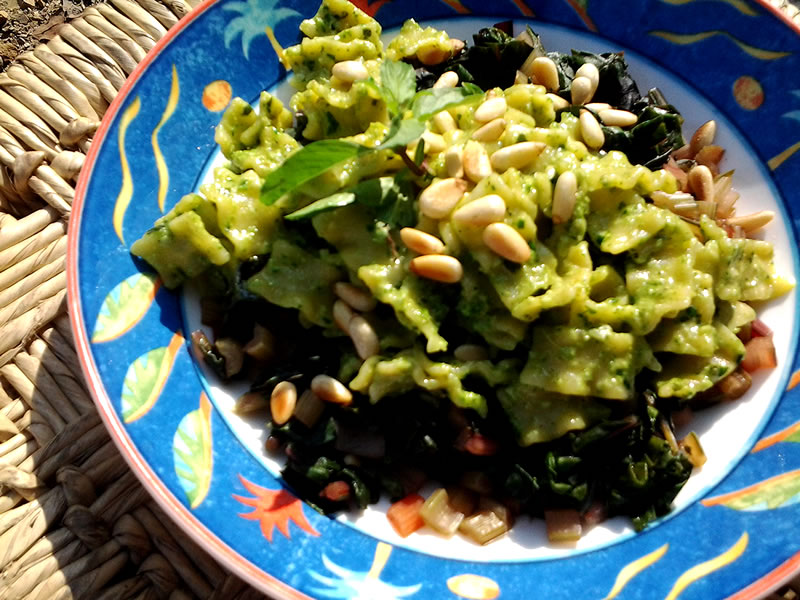I was shocked to discover last week that one pot of my precious arugula, which has been growing so well this season and has been a joy to devour in salads and other dishes, had become infested with the persistent parasite, Cuscuta, more commonly known as dodder. Dodder is a nasty, easily-spread, and fast-growing parasite much feared by gardeners. It’s really hard to get rid of, and can spread at the whiff of a sea breeze. A few of its common names are devil’s guts, devil’s hair, and devil’s ringlet,
Although the dodder in my garden hadn’t had much of a chance to latch on and spread, there were still enough little tendrils wrapped around a few of the arugula stems to make me very nervous. I found no indications of it anywhere else in my garden, and I hadn’t noticed it nearby in any of the neighboring lots or yards. It must have wafted in on the breeze or come in on my or someone else’s clothing from parts unknown.
After intense investigation, I decided that my only option was to get rid of the crop and the soil in that pot. I’ll put in new soil and for a couple of years at least will plant other edibles that are not common hosts of Cuscuta: monocotyledons such as onions, chives, or gingers.
So out came the scissors. Fortunately, very few tendrils of the parasite had managed to attach themselves and it had spread very little. I discarded stems that had tendrils attached and burned them. But I still was able to harvest much of the fresh, green, and healthy arugula. There was a lot of it–about three packed cupfuls–and I needed either to process it for storage or to eat it immediately.
Solution: Arugula pesto
I could have my arugula and eat it, too. I prepared a bold and spicy arugula-based pesto pasta (see the recipe below, under the photo) and heaped it on steamed Magenta Sunset Swiss chard, also freshly picked out of the garden. What a combo! I hope you enjoy it as much as I do.
After a dodder attaches itself to a plant, it wraps itself around it. If the host contains food beneficial to dodder, the dodder produces haustoria that insert themselves into the vascular system of the host. The original root of the dodder in the soil then dies. The dodder can grow and attach itself to multiple plants. In tropical areas it can grow more or less continuously, and may reach high into the canopy of shrubs and trees; in temperate regions it is an annual plant and is restricted to relatively low vegetation that can be reached by new seedlings each spring.
–Wikipedia contributors, “Cuscuta,” Wikipedia, The Free Encyclopedia, http://en.wikipedia.org/w/index.php?title=Cuscuta&oldid=602839422 (accessed April 19, 2014).

Arugula Pesto on a Bed of Swiss Chard
3 cups packed fresh arugula
1/2 cup walnuts, lighted toasted
1/3 to 1/2 cup olive oil or other virgin or cold-pressed oil (I used a combination of olive and sesame–not toasted sesame oil, which has a very strong flavor, but plain, cold-pressed sesame oil)
4 cloves garlic, roasted in their skins on a grill or cast iron frying pan until softened
1 clove fresh garlic, crushed
2 T fresh basil leaves
1 T nutritional yeast (optional)
the zest and juice of 1 lime
1 T toasted pine nuts to garnish (optional)
1 cup pasta of your choice (I used gluten-free corn pasta, but any will do)
1 bunch Swiss chard, stems sliced finely and leaves torn or sliced more coarsely
a grating of fresh nutmeg
salt and pepper to taste
Toast the walnuts and the garlic. Process the arugula, oils, toasted and raw garlic, walnuts, basil leaves, nutritional yeast, lime juice and zest, and salt and pepper to taste in a food processor or blender until smooth. Inhale the goodness.
Steam the Swiss chard and season with salt to taste and a grating of fresh nutmeg.
Cook the pasta in plenty of salted boiling water per pasta instructions and drain. Toss with as much of the arugula pesto paste as you desire.
Place a generous layer of Swiss chard on a plate and mound with the pesto-slathered pasta. Top with toasted pine nuts and a sprig of basil. Eat.
The recipe is for 2 healthy servings of Arugula pesto with Swiss chard.
The pesto part of the recipe, though, will give you 1-1/2 cups or more of pesto paste. Store the excess pesto in a covered glass container in the fridge for a week or so or freeze in ice cube trays then store in bags or a freezer container for later use. The individual cubes can be thawed and easily used on pasta or drizzled on veggies or as a spread for sandwiches or crackers.